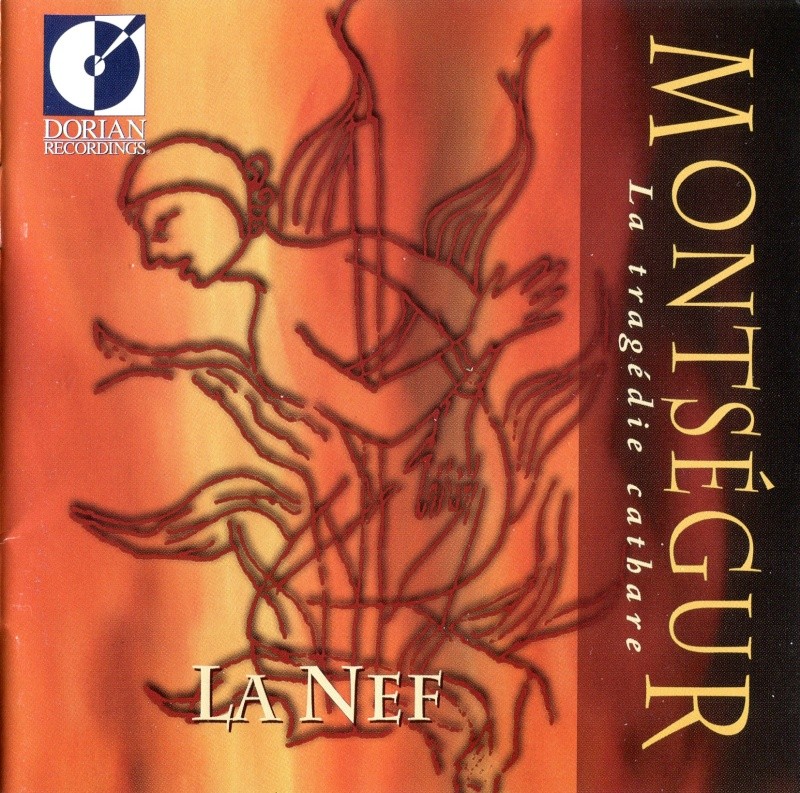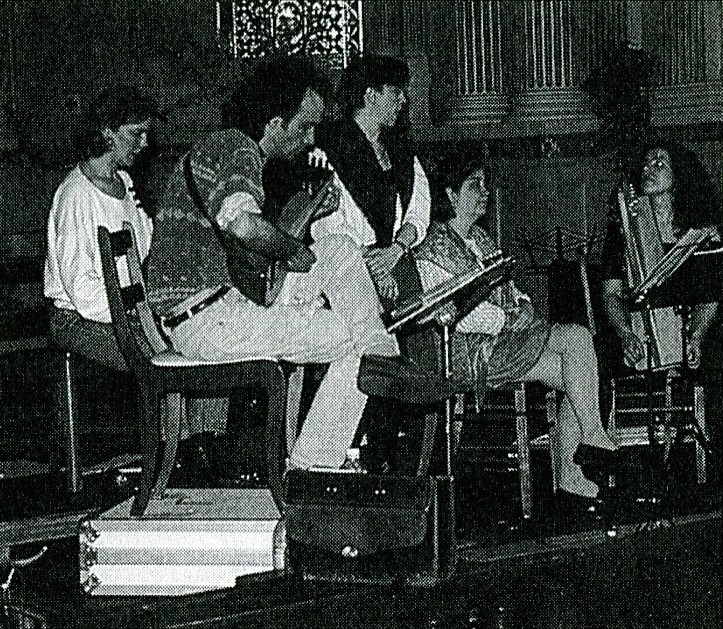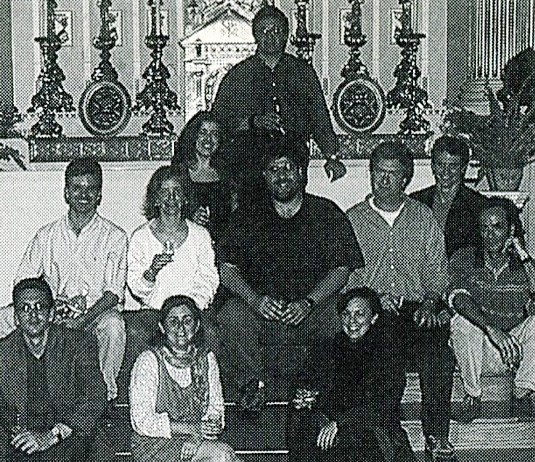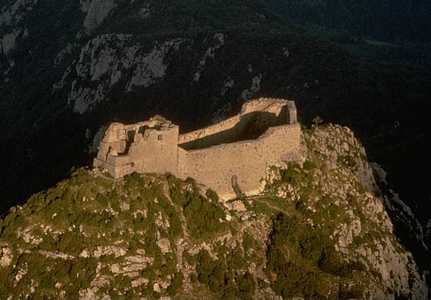
Dorian Recordings DOR-90243
1996

Dorian Recordings DOR-90243
1996
This
is a dramatic recital, using troubadour and other 13th century music to
illustrate some conceptual scenes from the Crusade against the Cathars
(1209-1255). The Cathars were a well-entrenched heretical Christian sect
in the South of France, advocating such things as the spiritual
equality of man & woman. Many people have made some small links
between the Cathars and the emergent troubadour repertory. If one is to
designate their theology as a major motivation for the love poetry of
the troubadours, one must keep well in mind that these poems are
formally similar to classical Latin poems by such writers as Ovid. —
medieval.org
MONTSÉGUR ·
LA TRAGÉDIE CATHARE —
Catalog No. DOR-90243
MONTSÉGUR Alain Bergeron
THE MUSIC
1. Ouverture “Reis Gloriós” [2:40]
Sylvain Bergeron, d'après Guiraut de BORNEIL
EL FIN' AMORS
2. Beata viscera [5:02] PEROTIN
3. La Tierche Estampie Roial [3:50]
4. Quand vey la lauzeta mover [5:28] Bernard de VENTADOUR
5. Loc tems ai / Lo ferm voler [4:02]
Sylvain Bergeron, d'après Raimon de MIRAVAL et Arnaut DANIEL
LA FLÉAU
6. Alle Psalite / Reis Gloriós [1:26]
Sylvain Bergeron d'après Anonyme et Guiraut de BORNEIL
7. Des Oge mais [3:01] ALFONSO X El Sabio
Cantiga 1
8. La Quarte Estampie Royal [2:24]
9. A chantar m'èr [6:39] Condessa de DIA
10. La Septime Estampie Real [2:21]
11. La Seconde Estampie Royal [1:25]
12. C'est la Fins / La Quinte Estampie Real [3:38]
13. Falsedatz et desmezura [5:11]
Sylvain Bergeron, d'après Peire VIDAL; Texte de Peire CARDENAL
CONSOLAMENTUM
14. Benedicite Parcite Nobis [3:12]
Sylvain Bergeron, From the Lyons Ritual/Texte tiré du Rituel Cathare
15. Virgen, madre gloriosa [1:53] ALFONSO X El Sabio
Cantiga 340
16. Jhesu Crist [3:48] Guirault RIQUIER
17. Reis Gloriós [8:25] Alba · Guiraut de BORNEIL
FEUX
18. Veni Sancte Spiritus [5:02]
Sylvain Bergeron, d'après Guillaume d'AMIENS
LA NEF
Sylvain Bergeron
Sylvain Bergeron — oud, psaltery, bells, voice
Claire Gignac — contralto, recorders, reciter
Viviane LeBlanc — soprano, psaltery
Éric Mercier — shawm, bagpipe
Vincent Dhavernas — percussion
Angèle Laberge — soprano, harp
Isabelle Marchand — bowed vielle, voice
Rafik Samman — baritone, percussion, oud

LA NEF
The
French word "nef" ("Nave": from the latin navis, 'ship") designated a
large sailing ship of the Middle Ages, a wooden "castle" with a rounded
stern and broad sails that carried crusaders to the Holy land, bringing
back gold for kings. This beautiful and noble name, "nef" or nave in
English, also came to be used for that part of the church reserved for
worship by the laity.
A venturesome world-faring vessel, today's La
Nef is seeking, discovering, exploring, making its ports of call in
distant times and ancient lands. It has gathered a faithful crew:
jugglers, minstrels, actors and jesters. La Nef takes you on an
adventure. In lieu of gold and weapons it carries songs. Sounds heard
over seas of yore, words and melodies collected from foreign shores and
forgotten ports.
* * *
The ensemble La Nef was
created in the spring of 1991. During the last 15 years, all of its
members have been associated with the major ensembles of early music of
Québec. Since its founding, La Nef has presented more than 200
performances and participated in major international series and
festivals including Early Music Now (Milwaukee, 1996), Festival
Internacional Cervantino (Mexico, 1994, 1996), Festival de Flandres
(Belgium, 1993), and Festival de Musica El Hatillo (Venezuela, 1992).
The musical role of La Nef
is to examine the ancient repertoire in its original state, being
flexible and adaptable to restructuring and re-creation. The integration
of a theatrical dimension in its productions throws a new light on the
music. It allows the listener to better perceive the profoundness and
richness of the emotions contained in this music from the past.
Montségur is La Nefs third recording. Music for Joan the Mad [DIS-80128] and The Garden of Earthly Delights [DIS-80135] are available on the Dorian Discovery* label.
LIST OF SOURCES / SOURCES MUSICALES
• Secular music/musique profane
— Anthologie des Troubadours ·
Pierre Bec, ed., (Paris: Bibliothèque médiévale, 1979)
— Poésie lyrique au Moyen-Age (Paris: Librairie Larousse, 1965)
— Medieval Dances ·
Timothy J. McGee (University of Toronto press)
• Religious music
— École de Notre-Dame (Léonin)
— Cantigas de Santa Maria (Alphonse le Sage)
INSTRUMENTS USED IN THIS RECORDING
— Oud:
Oud (Dincer Dalkilic, Philadelphia, PA, USA, 1975)
Syrian Oud (unknown builder; modified by Eduard Rusnack, Montreal, 1992)
— Harp: Medieval Harp (Susie Norris, Plainfield, VT, USA, 1985)
— Bowed vielle: 5-string (anonymous, NH, USA, 1984)
— Psaltery: (Claude Guibord, Montreal, 1995)
— Recorders:
Alto, tenor, soprano (Levin Silverstein)
Sopranino (Moeck, 1978)
— Shawn/chalémie: Catalonian/Spanish Shawm (John Hanchett, Dusseldorf, 1987)
— Bagpipe: Veuze Bagpipe (Hervieux & Glet, Redon, Brittany, 1985)
— Bells/cloches: White Chapel Bells (England, 1973)
— Percussions:
Derbouka instruments with metal base
Egyptian Eel Skin Drum
Egyptian day drum
Ocean Drum

Recorded at l'église de la Nativité de la Ste-Viérge, Québec in May 1996
Producer: David H. Walters
Engineers: Craig D. Dory, David H, Walters, Brian C. Peters, Debbie Reynolds
Editor: David H. Walters
Booklet Preparation & Editing: Katherine A. Dory
Graphic Design: Kimberly Smith Company
Executive Producer: Brian M. Levine
Conception and Musical Direction: Sylvain Bergeron
Artistic Direction: Sylvain Bergeron, Claire Gignac,Viviane LeBlanc Historical research: Alain Bergeron
Translation: Ann Rajan assisted by Sybil Murray-Denis, Louise Lafond
Photography: Jean-Louis Gasc, Denis McCready, Craig D. Dory
Acknowledgements: Le Centre National d'Études Cathares, Franc Bardou, Pierre Vellas, Laurent Major, Normand Cazelais, Douglas Kirk
The
concert that helped prepare this recording was given at the Redpath
Hall of McGill University in Montreal, on June 9,1995. It was produced
with the assistance of the Société Radio-Canada (French CBC network).
The
creation of this program was made possible with the support of the
Conseil des Arts et des Lettres du Québec (Programme d'aide aux
Artistes) and the Canada Council (Explorations Program).
℗ © 1996 DORIAN RECORDINGS® a division of The Dorian Group, Ltd.

Long
ago, the Cathars built a castle on the summit o a mountain, and this
castle was also a temple and a refuge. Its walls were cliffs mounted
upon cliffs as strong and as desperate as the hearts o its inhabitants.
In the land of the troubadours , Montségur gave shelter to the most
exacting purity.
But one day, barons came down from the North,
crusaders of Babylon the Catholic. They burnt its flesh and left only
its huge bones of stone, a twisted skeleton still crumbling today under
the sand and wind o centuries.
Assassinated, Montségur survives, a proud fortress gazing, in arrogant silence, on worlds far beyond human ken.
Like
a ghost ensconced high above the Occitan countryside of France
Montségur, solitary, hoards the memory of a long-faded dream.
THE CATHARS
On
10 March 1208, Pope Innocent III called for a crusade. This time it was
not to free the Holy Land but to root out a heresy rampant in the very
heart of Christendom in the land of Raymond VI Count of Toulouse. Rome
had long fulminated against these heretics and the tolerance granted
them by aristocrats in the South of France. On January, Brother Pierre
de Castelnau, the papal legate was assassinated by an officer of Raymond
VI. The pope could not have hoped for a better pretext to strike.
Who
were those people we call the Cathars and against whom was launched a
merciless decades-long crusade? There is no easy answer to this
question. Today, the Cathar phenomenon is still shrouded in mystery and
confusion. War, the Inquisition, and the ravages of time have left us
very few Cathar documents of irrefutable authenticity. What we know
about them is often based on late or hostile sources. Even the
designation Cathar (from the Greek kathoros meaning pure is open
to debate, as those referred to by this name did not themselves use it.
They saw themselves as true Christians - indeed, the only genuinely
"good Christians" - and they looked upon the Roman Catholic church as a
new Babylon dedicated to Satan. On the other hand many of their beliefs
were closely akin to Eastern religions. The absolute opposition of good
and evil, the fundamental duality of mind and matter were directly
inspired by Persian Manicheism. Other elements recall Hinduism and
Buddhism: renouncement of the world, praise of suicide, belief in
reincarnation, and a vegetarian ethic. We know that a Christian form of
Manicheism appeared in the Near East during the first centuries of the
Church. It spread via the Byzantine Empire across the Balkans and the
North of Italy before reaching Languedoc and Catalonia in about the
eleventh century. Catharism took root in the South of France and was
particularly well established in Toulouse and the western parts of
Languedoc, with Beziers, Carcassonne, Albi, and Foix as the main
centers.
What is remarkable about these heretics is that they
lived, apparently with little friction among ordinary Christians and
were even regarded with much sympathy by the population. Cathars
recognized two classes of the faithful: simple believers and Perfects.
Perfects were those who accepted to receive the initiatory sacrament
called the consolamentum. The highest degree of moral rectitude
was demanded of them. They led exemplary and often edifying lives. Their
simplicity, altruism and austerity, which stood in stark contrast to
the corruption and cynicism of so many among the official clergy,
brought them numerous converts.
From a political standpoint, the
vast region of Languedoc - called Occitania from the 19th century on -
then lay under the influence of the counts of Toulouse. The kings of
France, long engaged in process of state centralization saw these counts
as formidable rivals. During the 12th and 13th centuries, Languedoc
culture was considered one of the most sophisticated in all of
Christendom, with the possible exception of Byzance. Toulouse was the
third largest city in Europe. Philosophy was there held in great esteem
as was poetry, and both these forms of expression were strongly
impregnated with Eastern influences. The Arabian world was not very far
away, and Languedoc had seen crusaders returning from Palestine cross
its lands. And just on the other side of the Pyrenees lay the kingdom of
Aragon, one of the main crossroads for the highly complex exchanges
between Islamic and Christian cultures.
It is well known that the
Cathars enjoyed the support of the leading families of the aristocracy
of the South. A high proportion of the Perfects were of noble birth.
Moreover, the Catharist heresy and the courtly art of the Troubadours
flourished in the same soil, although it would be presumptuous to posit a
direct link between the two. Poetic and courtly Fin 'Amors
nurtured new values that prevailed over the crass and violent traditions
of the warlike aristocracy. Essentially opposed to the norms of
Catholic morality, it flouted conventional unions through adultery. At
the heart of Fin 'Amors was the Domna, the beautiful inaccessible
mistress, the object of a passion that could be either erotic or
mystical in nature. Some have sought a parallel between this courtly
celebration of woman and the sexual egalitarism advocated by the
Perfects. Unlike Catholicism which held women as instruments of
temptation used by Satan, the Cathars saw men and women on an equal
footing, because, in their view, both sexes were the victims of Satan.
They condemned marriage and regarded procreation as a crime since it
meant the imprisoning of an innocent soul within a corporal prison
subject to the Devil's law. In practice, however, the moral code of the
Cathars showed them as being open-minded towards adultery with
considerable tolerance for brief amorous adventures among the common
believers. Only the Perfects, who represented a minority, were
constrained to complete chastity.
In the early 13th century,
having tried in vain to dispel the heresy through preaching, the Church
deemed the moment propitious to take more effective action. The Barons
who were summoned would find very conveniently, that their Crusade was
close at hand. Moreover, they were granted the indulgences usually
conferred on those who took up the Cross. The chief star of the Crusade
was Simon IV Count of Montfort, who had won fame in the Holy Land for
his campaign against the Saracens, and who coveted the title of Count of
Toulouse.
While Montfort and his captains waged a campaign of
armed terror, monks mandated by the Pope and his Bishops kept the people
in spiritual bondage. The country was laid waste by armies and the
great machine of the Inquisition judged and condemned thousands of
Cathars to be burned at the stake. Countless stories of untold horrors
described torture and death. Bodies of heretics were exhumed and burned.
Good Christians, deemed suspect, perished in the same manner ...
In
its various stages the Crusade lasted from 1209 to 1255 (Queribus
taken). But the event that was to capture the imagination of future
generations was the siege of Montségur. Built at the summit of an
extremely steep mountain, some 1,200 meters high, this fortress served
as a refuge. Here persecuted heretics found asylum, as did knights and
men of arms being sought by Simon de Montfort's Crusaders. From the very
beginning, the place was also used as a sanctuary by the Catharist
Church and it soon became one of the main centers of resistance for the
occupants. Here at Montségur, an arsenal was secured, plots devised and
preparations made to enable people to go underground.
In May
1243, Hugues des Arcis, Seneschal of Carcassonne, finally established
his armed forces at the foot of Montségur rock. The strategic position
of the castle severely restricted the choice of operations for the
attacking forces. So the siege was a lengthy one. In November, an
expedition of Basque montagnards gave the French a tactical position
enabling catapult attacks. While those under attack could respond in the
same way, their main supply source was soon cut off. By around
Christmas the attackers succeeded in taking the perimeter of the summit
though the Cathars managed to hang on throughout the month of February,
hoping for reinforcements that never arrived. In desperation, they tried
to attack enemy positions but their situation soon became clear. On
March 2, 1244, Montségur surrendered after ten months of siege. Although
about 500 people were then inhabiting the fortress, this included only
about 150 to 200 Perfects. The conditions of surrender were rather
peculiar. A 15-day truce was called. Perfects who renounced their errors
before the Inquisition would be punished but not killed. The rest would
be burned at the stake.
Rather than weakening the Cathars' ranks
it reinforced them. Some twenty men and women chose the supreme rite of
consolamentum, joining the contingent of martyrs. At dawn on March 15,
somewhere between 200 and 225 Perfects (the numbers vary depending on
sources) were brought to the base of a stockade on the slope of the
mountain, where a bonfire was already ablaze.
Following this
event other Cathar fortresses would fall but none with the mythical
significance of Montségur. Later, during the Occitan era the defeated
fortress at Montségur would become the symbol of the South's resistance
to the centralizing influence of the North. Thousands made the
pilgrimage annually to the ruins of Montségur. And it matters little
whether the ruins we view today are truly those of the Cathar fortress
or whether they are the remains of a castle subsequently built by Guy de
Lévis Lord of Mirepoix. Legends endure. And the spirit of the Cathars
lives on among the stone ruins of Montségur.
Virtually
no authentic written document on the Cathars remains. Their musical
practice is unknown to us. However, the Cathar phenomenon flourished in
the same region and during the same era (12th-13th centuries) as the
Troubadour repertoire. Various poetical texts of the Troubadours relate
closely to the Cathar era, expressing the ideas and actions in like
manner. They sing of love, religious or carnal, the higher human values,
nobleness of heart.
Drawing upon basic material which is essentially medieval, La Nef
here offers an original musical realization for voice and early
instruments. The sources have been selected orchestrated and interpreted
in keeping with the concept of opposition. The doctrine of the
Cathars rests on the antagonism between Good and Evil. And history has
retained a dualistic notion of the Albigensian drama: North against
South, invading crusaders against a martyred people. The Church of Rome
against the Perfects or Bonhommes as they were also called).
From
one side loud thunderous sounds of the bagpipes, shawms, percussion.
From the other, the soft instruments (harps, lutes, flutes), women's
voices, the poetry of the Troubadours.
1. Ouverture "Reis Gloriós" • S. Bergeron (after/d'après Guiraut de Bomeil)
Instrumental
The disc begins with an instrumental piece based on the well-known melody Reis Gloriós.
Successively, then in opposition, this overture renders the sounds of
forces present: loud and soft instruments, women's voices. The
magnificent melody, written in Dorian mode, also serves as the program's
leitmotif.
El Fin 'Amors
This
scene depicts the period immediately preceding the Albigensian Crusade.
Evoked here is a way of life in the South of France, which is at once
gentle, refined, hinting of decadence, with a rich and sumptuous but
fragile beauty. The instrumentation calls especially upon the string
instruments: harps, psalteries, vielle, oud.
2. Beata viscera • Perotin
3. La Tierche Estampie Roial • Anonyme /
Instrumental
4. Quand vey la lauzeta mover • Bernard de Ventarour
5. Lonc tems ai / Lo ferm vole • S. Bergeron (d'après Raimon de Miravel et Arnaut Daniel) /
Instrumental
Le Fléau
The
main aspect of this scene is extreme brutality, the ruthless and
decisive character of the devastation wrought by the Crusaders. The
sonorities are loud, piercing, direct. By literally stamping out the
spellbinding sounds of the people of the South, they crush them beneath
their boots.
But this incipient war is no ordinary military
campaign, it is also a Crusade. And from Rome, superimposed on this
unleashing of brute force, is the blessing of the Church. The "Alle Psalite cum Luya"
resounds over the warlike rumblings. The shawm issues its call from the
heights of the ramparts, the percussion pounds the earth, the bagpipe
screams out its retinue of horrors.
6. Alle Psalite / Reis Gloriós • Sylvain Bergeron (d'après Anonyme et Guiraut Borneil)
7. Des Oge mais (Cantiga 1) • Alfonso X el Sabio
8. La Quarte Estampie Royal • Anonyme /
Instrumental
In this Hell of violence, a lone song of love (A chantar m'èr) tries in vain to appease the combatants.
9. A chantar m'èr • Condesa de Dia
10. La Septime Estampie Real • Anonyme /
Instrumental
11. La Seconde Estampie Royal • Anonyme /
Instrumental
12. C'est la Fins / La Quinte Estampie Real • Anonyme /
Instrumental
The denunciatory text of the "sirventes against occupation" (Falsedatz et desmezura)
constitutes the Cathars' response to the invasion. In vain. The
Crusaders launch their final attack. Montségur is taken.
13. Falsedatz et desmezura • Sylvain Bergeron (d'après Peire Vidal; Texte de Peire Cardenal)
Consolamentum
This
scene strikes to the core of the Cathar thinking, its spirituality, its
rites, its secrets. The Perfects of Montségur have had their truce. For
them, all that remains is to pray. On this last night at the fortress,
some request the last rites. The "Benedicite Parcite Nobis" is at
once solemn, hypnotic, mesmerizing. The music of this scene has a sole
purpose: to strengthen faith and lead forward to martyrdom.
14. Benedicite Parcite Nobis • Sylvain Bergeron (From the Lyons Ritual/Texte tiré du Rituel Cathare)
15. Virgen, madre gloriósa (Cantiga 340) • Alfonso X el Sabio
16. Jhesu Crist • Guirault Riquier
Dawn
is nigh. Here the "Reis Gloriós" is offered a final time in a spare but
extremely dramatic version. The text of this "song of daybreak" first
evokes the growing anxiety for the companion's absence, following a
night of love, awaiting reunion which grows later as dawn arrives. Here a
wholly different meaning is expressed.
17. Reis Gloriós (Alba) • Guiraut de Borneil
Feux
The
Perfects walk voluntarily to death. A serene walk, but at once horrible
and terrifying. In assuming their martyrdom, the Perfects knew how to
summon all their energies: the gesture is collective, unanimous,
advances in unison of step and voice. Each person draws strength from
the common flow of movement that carries them on. But these are not
robots walking to unspeakable torture. Doubt, fear, sheer love of life
may still haunt them scarcely a few feet from the stake. The walk itself
is a vast procession to the beyond, suggested by the constant rise of
sonorities to higher registers. It is the passage from the crass
material world to the absolute kingdom of the Spirit. The Perfects are
the chosen ones whom God has called. The Consolamentum which
leads to martyrdom represents the gates they will enter to the promised
Paradise. One by one the sonorities "burn," disappear in the fire,
vanish. This is the end.
18. Veni Sancte Spiritus • S. Bergeron (d'après Guillaume d'Amiens)
